
# Wind Measuring Instrument: A Comprehensive Guide to Anemometers and Wind Vanes
Wind measurement is a critical aspect of meteorology, environmental monitoring, and various industrial applications. Accurate wind data helps in weather forecasting, aviation safety, and optimizing renewable energy systems. Two of the most commonly used wind measuring instruments are anemometers and wind vanes. This guide provides an in-depth look at these devices, their types, and their applications.
## What is an Anemometer?
An anemometer is a device used to measure wind speed. It is an essential tool for meteorologists, climatologists, and engineers. There are several types of anemometers, each with its unique mechanism for measuring wind speed.
### Types of Anemometers
1. **Cup Anemometers**: These are the most common type of anemometers. They consist of three or four cups mounted on horizontal arms, which rotate when the wind blows. The rotation speed is proportional to the wind speed.
2. **Vane Anemometers**: These devices combine a wind vane and an anemometer. They measure both wind speed and direction. The vane aligns itself with the wind direction, while the anemometer measures the speed.
3. **Hot-Wire Anemometers**: These use a heated wire that cools down when exposed to wind. The rate of cooling is used to calculate the wind speed. They are highly sensitive and used in precise measurements.
4. **Ultrasonic Anemometers**: These use ultrasonic sound waves to measure wind speed and direction. They are highly accurate and used in advanced meteorological applications.
## What is a Wind Vane?
A wind vane, also known as a weather vane, is a device used to measure wind direction. It typically consists of a flat surface that rotates to align itself with the wind direction. The most common design is an arrow that points into the wind.
### Types of Wind Vanes
1. **Traditional Wind Vanes**: These are the classic designs often seen on rooftops. They are simple and effective for basic wind direction measurement.
2. **Electronic Wind Vanes**: These are more advanced and often integrated with anemometers. They provide digital readouts of wind direction and are used in professional meteorological stations.
3. **Combined Instruments**: Many modern devices combine wind vanes with anemometers to provide comprehensive wind data. These are widely used in weather stations and research facilities.
## Applications of Wind Measuring Instruments
Wind measuring instruments are used in a variety of fields:
– **Meteorology**: For weather forecasting and climate studies.
– **Aviation**: To ensure safe takeoffs and landings.
– **Renewable Energy**: To optimize the placement and operation of wind turbines.
– **Agriculture**: To monitor wind conditions that affect crop growth and pest control.
– **Construction**: To ensure safety and stability in high-rise building projects.
## Conclusion
Anemometers and wind vanes are indispensable tools for measuring wind speed and direction. Understanding their types and applications can help in selecting the right instrument for specific needs. Whether for professional meteorological stations or personal weather monitoring, these devices provide critical data that impacts various aspects of our daily lives and industrial operations.
By choosing the appropriate wind measuring instrument, you can ensure accurate and reliable wind data, which is essential for making informed decisions in numerous fields.
Keyword: wind measuring instrument

Leave A Comment